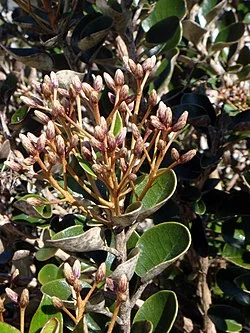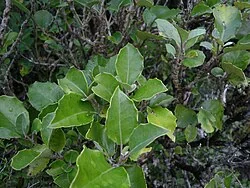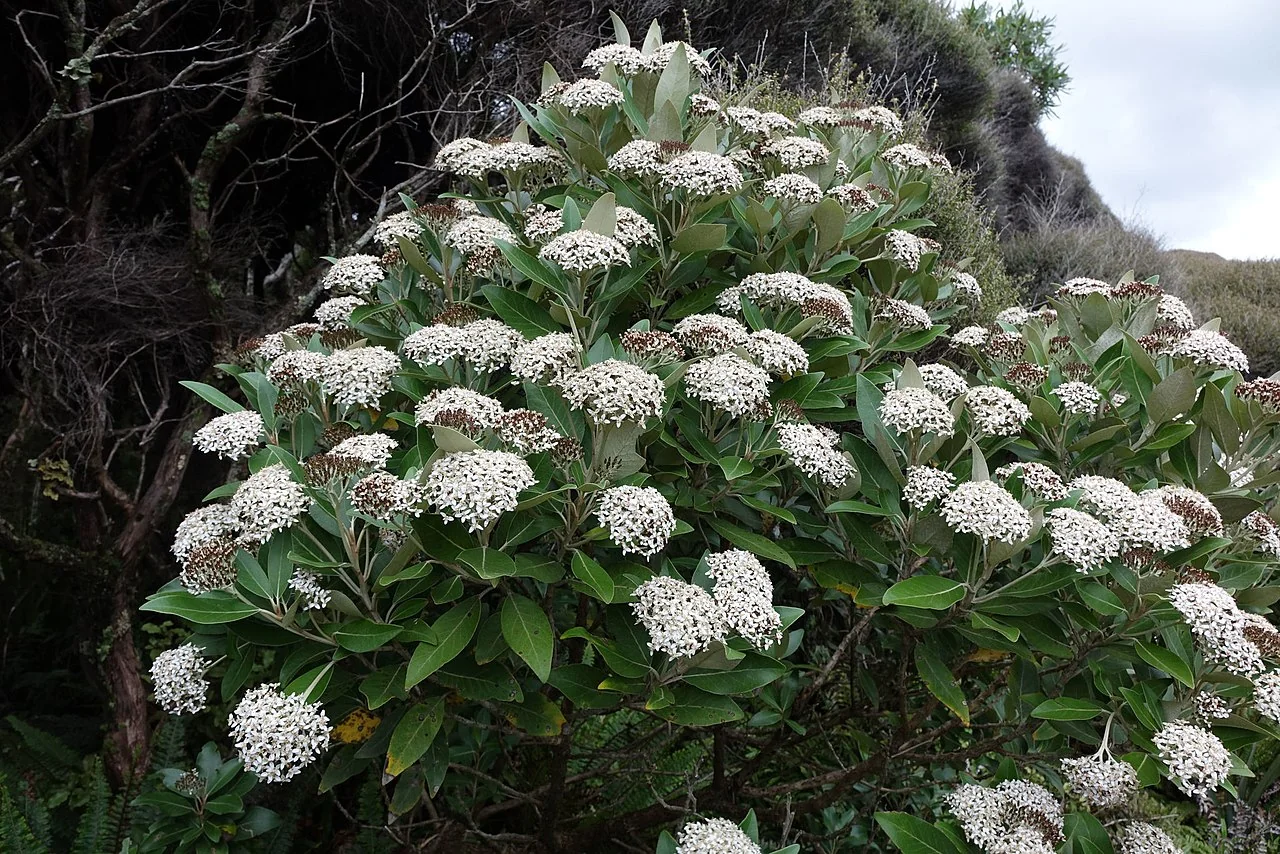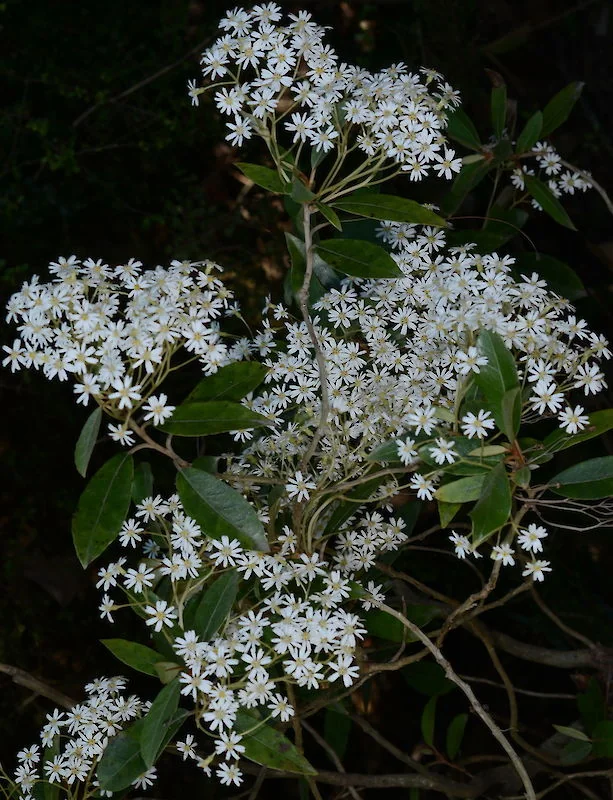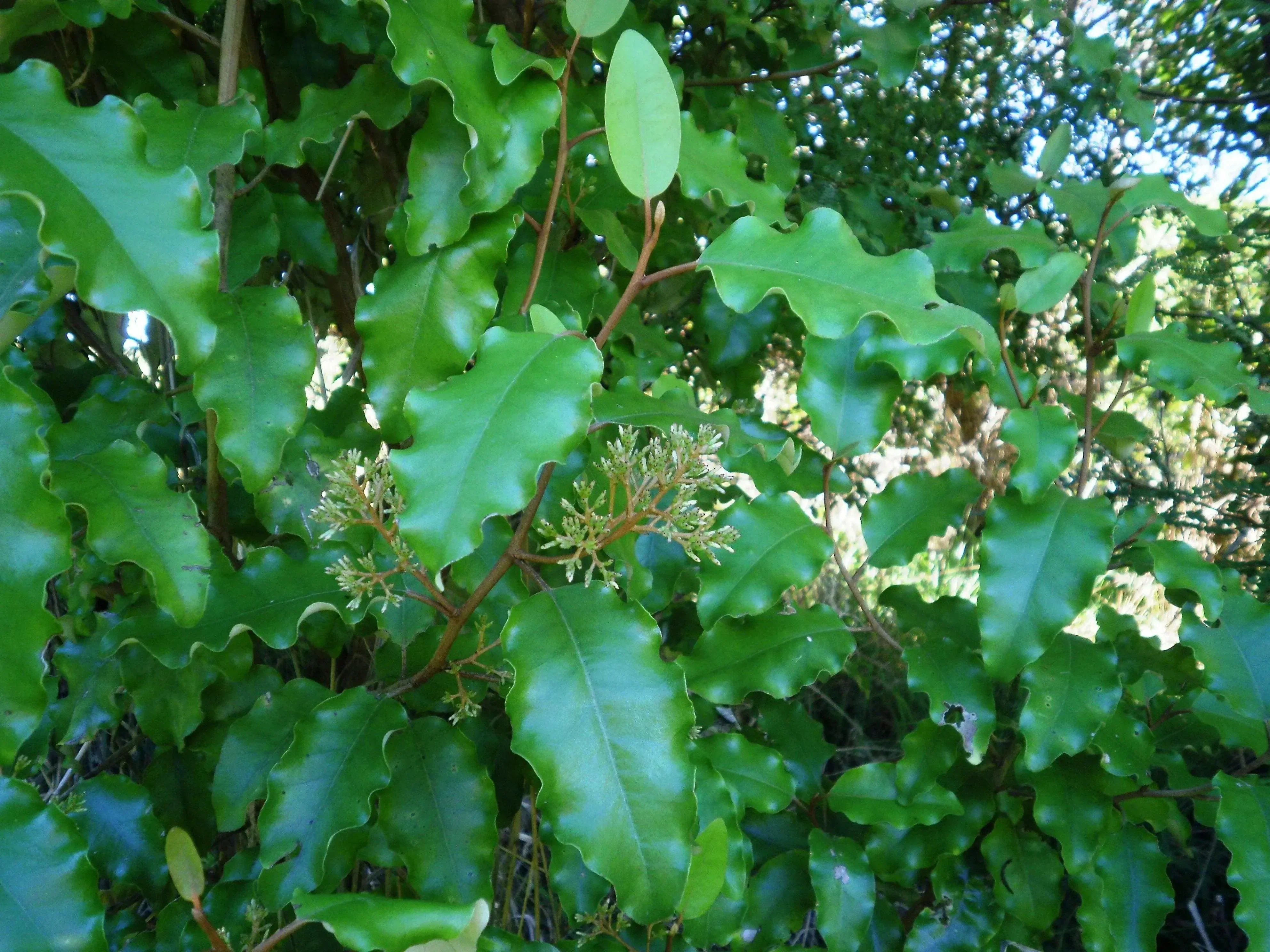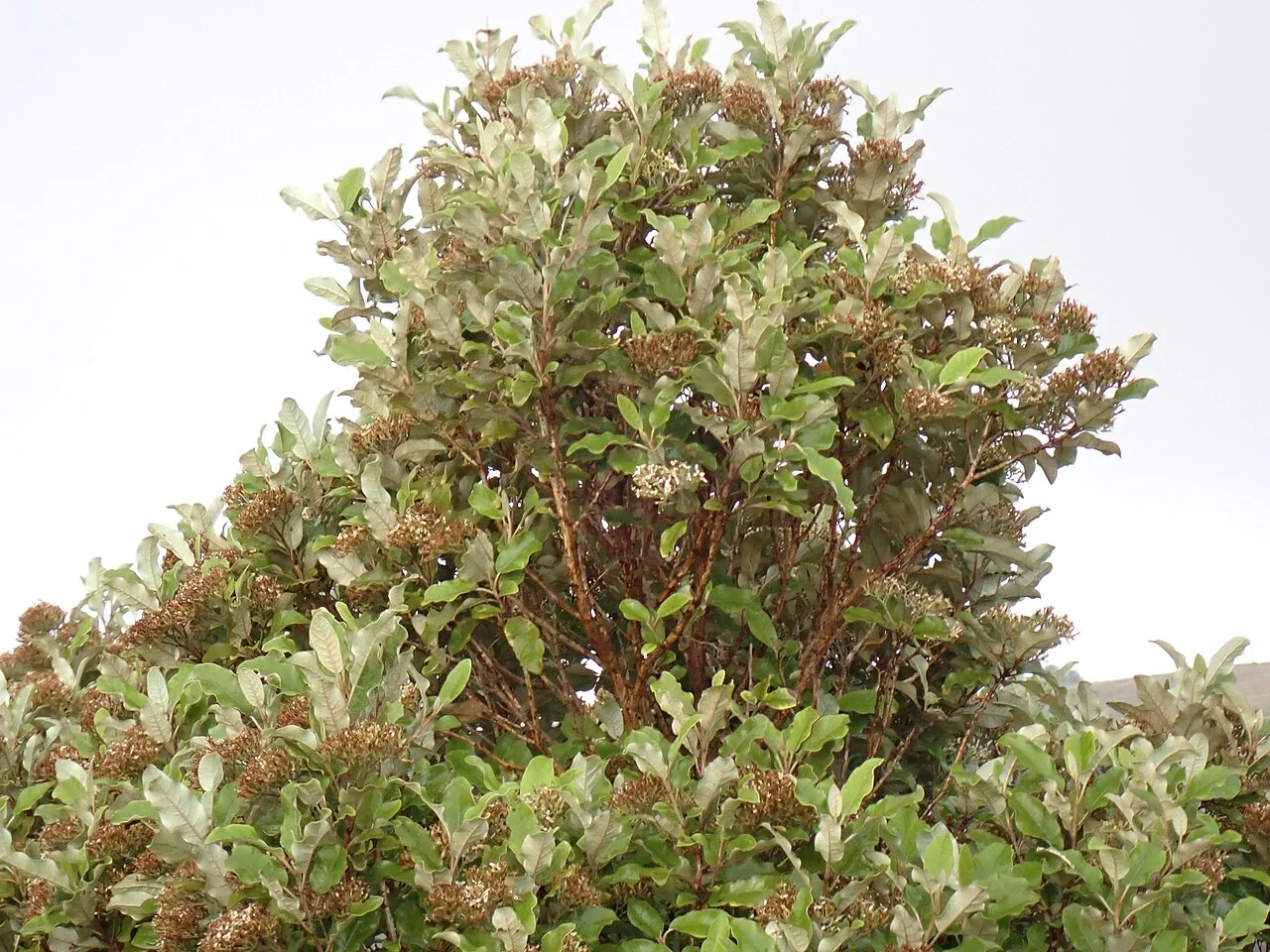
Tanguru
Olearia albida
Introduction
About Tanguru
Olearia albida , commonly known as Tanguru, is a hardy native tree daisy that forms an attractive, bushy shrub or small tree distinguished by its distinctive white-backed leaves and prolific clusters of small white or cream daisy flowers. This robust member of the Asteraceae family is naturally found in coastal and lowland areas throughout New Zealand, where it has adapted to challenging conditions including salt spray, wind exposure, and variable soil conditions. Tanguru is particularly valued in cultivation for its exceptional hardiness, fast growth rate, and spectacular late-season flowering displays that provide crucial nectar resources when many other plants have finished blooming, making it an excellent choice for wildlife-friendly gardens and coastal restoration projects. Explore more in the native plants index .

Plant Description
Botanical Features
Tanguru ( Olearia albida ), also known as tree daisy, is a broadleaf evergreen shrub or small coastal tree, typically growing 3-5 meters tall, but can reach up to 8 meters in its native range. It has leathery, light green to dark-green leaves with wavy margins that gradually taper to a point. The most distinctive feature is the soft, white, felt-like covering of hairs on the underside of the leaves, which gives the species its name "albida" (somewhat white). The tree has grooved, flaky bark. White, daisy-like flowers emerge in large clusters (panicles) during late summer through fall. These blooms are often fragrant and attract bees and beneficial insects. It is endemic to the northern North Island of New Zealand, where it is found in coastal areas, particularly on headlands, slip scars, rubble slopes, and canopy gaps within coastal forests.
Quick Facts
Overview
| Scientific Name | Olearia Albida |
|---|---|
| Height | 2-6 m |
| Spread | 2-4 m |
| Water Needs | Low to moderate |
| Light | Full sun to partial shade |
| Frost Tolerance | Moderate to good |
| Salt Tolerance | Moderate |
| Growth Rate | Moderate |
| Lifespan | Long-lived |
Climate Best Suited to
Regional climate suitability across major New Zealand cities.
Regional Suitability
| Whangārei | Ideal |
| Auckland | Ideal |
| Hamilton | Suitable |
| Rotorua | Suitable |
| Tauranga | Ideal |
| Gisborne | Ideal |
| New Plymouth | Ideal |
| Whanganui | Ideal |
| Palmerston North | Suitable |
| Napier | Ideal |
| Wellington | Ideal |
| Nelson | Ideal |
| Christchurch | Suitable |
| Dunedin | Suitable |
| Invercargill | Suitable |
| City | Climate Suitability |
|---|
Natural Habitat
Tanguru is primarily a coastal species, favoring coastal headlands where it often grows on slip scars, rubble slopes, or in canopy gaps among other coastal forest trees. It can also be found in coastal forest and scrub in the upper half of the North Island. This plant typically thrives in sunny locations with well-drained soil and is tolerant of sun, salt, and wind.
Plant Conservation
Conservation
Olearia albida , also known as tanguru or tree daisy, is a species of flowering plant endemic to the northern North Island of New Zealand. Its conservation status has recently been upgraded. In 2024, the New Zealand Threat Classification System (NZ TCS) changed its rating from "Not Threatened" to "Declining". As of 2023, it is classified as "At Risk - Declining" nationally, and in the Auckland region, it is considered "Threatened - Regionally Endangered" in 2025. The primary threats to Olearia albida populations include: invasive weeds, coastal erosion, animal browsing (livestock, feral goats, and possums), and land development and roadworks. While the species is widely distributed, many populations are in decline, with some showing limited or absent recruitment.
Growing Requirements
Soil Requirements
Free-draining soils are essential. Tanguru performs well on coastal sands and light loams enriched with organic matter. Avoid heavy, waterlogged clays.
- Light, well-drained loams or coastal sands
- Mulch to conserve moisture and suppress weeds
- Avoid prolonged waterlogging
Light Requirements
Full sun encourages compact growth and abundant flowering; partial shade tolerated, especially inland.
- Full sun to light shade
- Shelter from severe, salt-laden winds improves leaf quality
Water Requirements
Low to moderate water needs once established. Maintain even moisture the first 1-2 summers.
- Regular watering during establishment
- Drought-tolerant later, especially in coastal soils
Planting Guide
1. Climate and Site Selection:
- Climate: Olearia albida thrives in coastal climates with moderate temperatures, preferring cool to mild conditions and disliking hot, humid weather. It is hardy in USDA zones 9-11 and tolerates light frosts but not severe cold.
- Sunlight: Choose a site with full sun to partial shade, ensuring at least 6 hours of direct sunlight daily.
- Protection: Young plants may require protection from severe frost. Consider coastal exposure for its natural wind resistance.
2. Soil Requirements:
- Drainage: It prefers well-drained, moderately fertile soil and tolerates poor coastal soils and sandy conditions. Avoid waterlogged or poorly draining soils.
- pH: It can handle a slightly acidic to alkaline pH range.
3. Planting:
- When to Plant: The best time to plant Olearia albida is during spring or early autumn when temperatures are mild and rainfall is more reliable.
- Mulching: Mulching around the base of the plant can help conserve moisture and reduce weeds.
Ecological Role
Environmental Benefits
Tanguru ( Olearia albida ) contributes evergreen structure to dry forest margins and shrublands. Daisy heads provide nectar and pollen to native insects, while the compact crown offers shelter and perches on exposed edges. By binding shallow soils and trapping litter, it helps retain moisture and resilience in drought‑prone habitats.
- Pollinator forage: Summer flowering supports generalist native insects.
- Edge buffering: Dense foliage reduces wind stress for understorey plants.
- Soil retention: Roots and leaf fall stabilise thin, free‑draining soils.
Uses and Significance
Produces spectacular massed displays of late-season daisy blooms that provide essential nectar and pollen resources for native bees, butterflies, and other beneficial invertebrates when few other plants are flowering. The dense branching structure offers valuable shelter and nesting opportunities for small native birds, while the distinctive white-backed leaves create visual contrast in mixed native plantings. As a pioneer species, Tanguru also helps stabilize coastal soils and provides wind protection for more sensitive plants in restoration projects.
Landscape Uses
Excellent for coastal gardens, hedging/shelter, and mixed native borders; responds well to light clipping.
Cultural Significance
Cultural Importance
Māori Uses and Contemporary Kaupapa
Olearia albida , also known as Tanguru, holds cultural significance in Aotearoa (New Zealand), particularly among Māori. It is valued for its practical applications and ecological services. The strong, dense wood of larger Olearia species, such as akeake, was utilized by Māori for crafting tool handles, weapons, and various construction materials. The name "akeake" itself reflects the wood's notable hardness and durability, making it highly prized for items requiring strength, like fence posts. Some Olearia species were also used in traditional medicines, with specific applications varying across different iwi (tribes) and regions. Beyond its direct uses, Olearia albida is valued in contemporary restoration efforts and gardens for the ecological benefits it provides.
Tanguru is commonly included in coastal restoration and kaupapa Māori plantings because it establishes quickly, shelters taonga species, and supports native pollinators. Planting eco‑sourced stock maintains local whakapapa of coastal shrub communities while restoring the mauri of exposed headlands and track margins.
Landscaping Ideas
Textured Coastal Daisy
- Hedges and screens: Clips into wind-filtering screens in coastal gardens.
- Mixed shrub borders: Pair with Pittosporum and Coprosma for evergreen structure.
- Pollinator value: Daisy flowers support insects; site in full sun for best bloom.
Tolerates wind and salt with good drainage. Mulch to conserve moisture during establishment.
Seasonal Care Calendar
Spring
Plant and tip-prune lightly to encourage bushiness.
Summer
Water new plants in dry spells; deadhead lightly if desired.
Autumn
Shape after flowering; apply mulch/compost.
Winter
Minimal inputs; ensure drainage is free.
Pruning and Maintenance
Techniques and Timing
Light, regular trimming immediately after flowering maintains a dense, bushy habit and prevents the plant from becoming leggy or open-centred. Tanguru responds well to gentle pruning but avoid hard cuts into old, bare wood as this can reduce vigor and flowering potential. Annual light shaping encourages fresh growth and maintains the compact form that maximizes flower production. Deadheading spent flower clusters redirects energy into new growth and can extend the blooming period.
How to Grow Tanguru
Tanguru is a hardy native tree daisy that forms an attractive, bushy shrub or small tree distinguished by its distinctive white-backed leaves and prolific clusters of small white or cream daisy flowers. This robust member of the Asteraceae family is naturally found in coastal and lowland areas throughout New Zealand, where it has adapted to challenging conditions including salt spray, wind exposure, and variable soil conditions. Tanguru is particularly valued in cultivation for its exceptional hardiness, fast growth rate, and spectacular late-season flowering displays that provide crucial nectar resources when many other plants have finished blooming, making it an excellent choice for wildlife-friendly gardens and coastal restoration projects. Understanding its propagation methods is key to successfully growing this delightful species.
From Cuttings
Semi-hardwood cuttings are a reliable and efficient method for propagating Tanguru, ensuring that new plants retain the exact characteristics of the parent. Take 8-12 cm cuttings from healthy, non-flowering shoots in late summer from current season's growth. Remove lower leaves and treat cut ends with rooting hormone before placing in a well-draining propagation mix. Maintain consistent humidity with misting or enclosed propagation chambers. Rooting typically occurs within 4-6 weeks under warm conditions. Once rooted, the new plants can be potted on and grown in a sheltered environment until they are ready for planting.
From Seed
Propagating Tanguru from seed is a viable method, though it requires fresh seeds and careful attention to conditions. Collect fine seed from dried flower heads in late autumn, storing in cool, dry conditions until sowing in spring. Surface-sow without covering on a free-draining seed mix, as seed requires light for optimal germination. Maintain consistent moisture without waterlogging, with germination typically occurring within 2-4 weeks under suitable conditions of 18-20°C. Seedlings establish quickly and can be transplanted when large enough to handle safely. This method is crucial for maintaining genetic diversity and for large-scale restoration projects.
Pests and Diseases
Coastal Hardy, Watch for Sap-Feeders
- Scale/aphids: Manage with oils or soaps; encourage airflow in hedges.
- Leaf spot: Remove affected leaves and avoid overhead watering.
- Poor drainage: Leads to root stress; plant on mounds in heavy soils.
Bonus Tip
Expert Growing Advice
Tanguru ( Olearia albida ) shows its white leaf undersides best in moving air and bright light. Site as a back-of-border screen where onshore breezes can ruffle the foliage - a simple way to accent the two-tone effect while helping keep the canopy dry and healthy.
